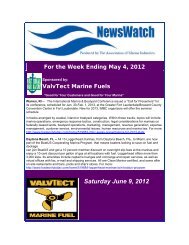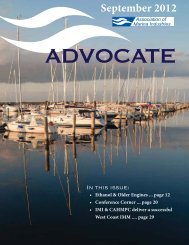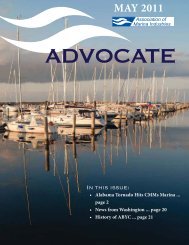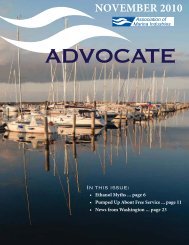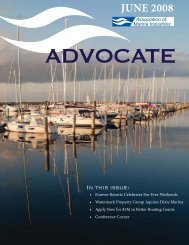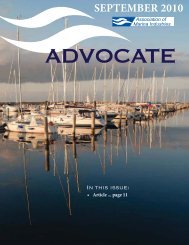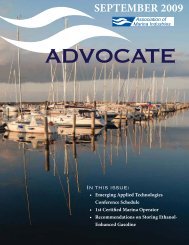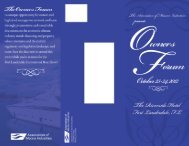Download a copy of AMI's Clean Marina best management practices ...
Download a copy of AMI's Clean Marina best management practices ...
Download a copy of AMI's Clean Marina best management practices ...
Create successful ePaper yourself
Turn your PDF publications into a flip-book with our unique Google optimized e-Paper software.
Appendix A<br />
11. SEDIMENT AND EROSION CONTROL<br />
Describe areas that have a high potential for significant soil erosion (primarily the shoreline) and<br />
the methods used to limit erosion (vegetation, restricted access, bulkhead, riprap, etc.).<br />
_____________________________________________________________________________<br />
_____________________________________________________________________________<br />
_____________________________________________________________________________<br />
_____________________________________________________________________________<br />
12. COMPREHENSIVE SITE COMPLIANCE EVALUATION<br />
Non Stormwater Discharges<br />
Visual inspections <strong>of</strong> all storm sewer inlets will be made quarterly during dry weather conditions<br />
for evidence <strong>of</strong> non-stormwater discharges. Visual inspections will be completed by an<br />
employee under the direction <strong>of</strong> the SWPPP Coordinator. The dry weather inspections will<br />
verify the site is not discharging sanitary or process water to storm sewers. Information<br />
recorded on the quarterly dry-weather inspection log shall include: date <strong>of</strong> inspection, storm<br />
sewer inlet location, inspection results, and potential significant sources <strong>of</strong> non-stormwater<br />
discovered through testing. If non stormwater discharges are identified, MARINA NAME will<br />
notify the DEQ as required in Part III D 3 g (3) <strong>of</strong> the Stormwater General Permit.<br />
Quarterly Visual Inspections<br />
___________________________________________________________ will perform quarterly<br />
visual inspections <strong>of</strong> all storm sewer inlets during rain events to look for evidence <strong>of</strong> stormwater<br />
contamination. Inspections will be conducted within the first thirty minutes <strong>of</strong> discharge or soon<br />
thereafter, but not exceeding 60 minutes. The visual inspection shall include any observations <strong>of</strong><br />
color, odor, turbidity, floating solids, foam, oil sheen, or other obvious indicators <strong>of</strong> stormwater<br />
pollution. Information recorded during the quarterly inspection shall include: date <strong>of</strong> inspection,<br />
storm sewer inlet location, inspection results, and potential significant sources <strong>of</strong> stormwater<br />
contaminants if discovered.<br />
Annual Compliance Inspections<br />
An annual stormwater compliance inspection will be conducted approximately one year<br />
following implementation <strong>of</strong> this SWPPP and annually thereafter. The inspection will determine<br />
if the BMPs have been implemented and will assess their effectiveness. The inspection will also<br />
determine if site operations have changed since development <strong>of</strong> this SWPPP. If operational<br />
changes have been made, the SWPPP Coordinator will determine if those changes will impact<br />
stormwater quality and develop new BMPs to address the change. All operational changes and<br />
new BMPs will be recorded in this SWPPP. Additionally, the inspection date, the inspection<br />
personnel, the scope <strong>of</strong> the inspection, major observations, and any needed revisions will be<br />
recorded. Revisions to the plan will occur within fourteen days after the annual inspection.<br />
Blank inspection forms can be found on the next pages.<br />
Stormwater Pollution Prevention Plan 12



